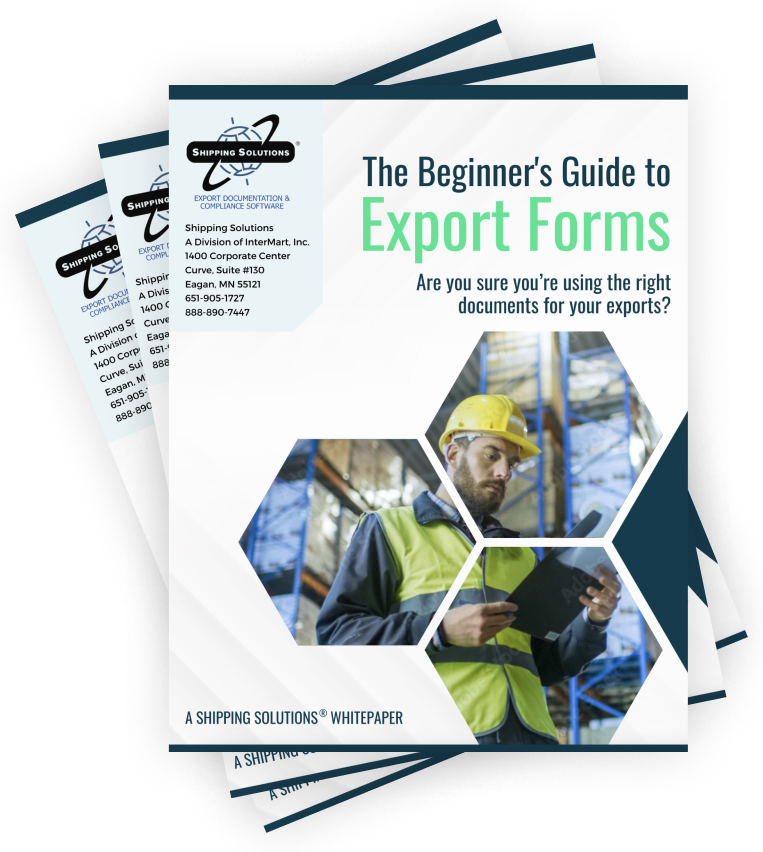The International Trade Blog Export Forms
7 Essential Resources for Completing Export Documents
On: May 21, 2025 | By:  David Noah |
6 min. read
David Noah |
6 min. read
 “Where do I even start?!”
“Where do I even start?!”
If you’re new to exporting, you may have uttered this phrase under your breath a few times, especially when asked to supply a set of documents for your export shipment. Even experienced exporters struggle with document creation, because the documents you need and the information they must contain can change based on what you're shipping, where you're shipping to, and how you're shipping.
The consequences of mistakes can be steep: incorrectly routed shipments and delays, products stuck at the border incurring growing demurrage fees, difficulties in getting paid, and potential penalties for import-export violations.
"Whew!"
But don't worry. If you know where to go for assistance, you can turn your export documents from a liability to an asset. Here are seven resources that can make completing your export documents easier. With these sources, you’ll be able to finish your paperwork more quickly, get answers to many of your questions, and learn information to help you in future exports.
1. Your Customers
When it comes to identifying which export forms you need to complete and what type of information you need to include, you should start by talking to your customers. Working with your buyers from the very beginning of the business relationship will help ensure you're prepared to complete the required paperwork when your goods are ready to ship. Here are some specifics to consider:
- Ask your customer outright what documentation they need, what they expect you to provide, and what they will provide in return.
- As part of the sales and negotiation process, agree on who is responsible for which documents. That way, there's no confusion, and you can meet your obligations on time.
- Your customer may need special documents to import the goods into their country, or there may be documents required by their bank or government.
Avoiding the "We've Always Done It that Way!" Trap
I'm sure this is true in every industry, but there are a lot of companies involved in international trade that have not reviewed or updated their import-export procedures for many millennia. And that includes the documents they request/require. While it's important to have a dialogue with your customer over what paperwork they want you to provide or specific ways you need to fill it out, don't be afraid to push back if a request seems incorrect or illegal.
I think it's important to be as accommodating as possible, but if a customer request is onerous, you can push back a bit and ask why they need it and request a copy of any regulations that require it. It may be the spark they need to review and update their procedures. And, of course, never comply with any request that is illegal or unethical.
2. Your Freight Forwarder
Your freight forwarder is one of your most important resources for preparing and completing export documents. A good freight forwarder will share their experience and expertise about the export process—including the required paperwork. That's why it's so important to choose your forwarder wisely, a topic I've written about before.
One thing to keep in mind: while a freight forwarder plays a key role in your export journey, they don't know your products as well as you do. That's why we don't recommend handing off the entire paperwork process to them. Instead, use your forwarder as a resource you can turn to with questions about specific procedures or the overall export process.
3. Your Bank
It should come as no surprise that your bank is an important resource. A good partnership with your bank will make it easy (or at least easier) to understand what you need to provide to support a letter of credit—or whatever payment method you choose to use.
- Bankers should know the details about each type of document and supporting information you need in order to facilitate a smooth letter of credit. They also should know the sticking points regarding letters of credit and any other payment type, and can advise you regarding the best payment methods for your exports.
- Investigate and interview several banks to determine a good fit for you. The international department of a bank will have experience with exports, and a good banker will be eager to answer your questions about getting paid for your exports.
- Make sure you are familiar with the EXIM Bank's Trade Finance Guide that explains the various international payment options and how to use them.
4. Your Local Export Assistance Center
If you haven't already, make an appointment with a staff member at the U.S. Commercial Service office located nearest you. As the trade promotion arm of the U.S. Department of Commerce's International Trade Administration, the 108 Commercial Services offices in the United States provide export counseling, market research, business matchmaking, participation in trade events, international partner searches, advocacy and more.
In addition to helping you find answers to your documentation and compliance questions, the Commercial Service offers a wide range of services to help U.S. companies analyze new international markets and find potential customers and partners in those markets. Read more about how these Export Assistance Centers can help your company.
5. District Export Councils
Working closely with the Export Assistance Centers, the District Export Councils (DECs) are groups of local business leaders, appointed by the U.S. Secretary of Commerce, whose knowledge of and expertise in international business provide a source of professional advice for their region's local firms.
One of those DECs, the Minnesota DEC (of which I was once a member), has published the ExportAssistance.com website, which includes a wealth of information about exporting. At this website you'll find samples of a variety of export documents, advice for completing these forms, and links to a variety of other resources important to exporters.
6. The Beginner's Guide to Export Forms
Based on the knowledge we have gained during the past 30 years helping exporters prepare their export paperwork, Shipping Solutions has published this free guide that explains more than 20 commonly used export forms, when and how they are typically used, and the information that you need to include on each form. It includes free templates for each form. And we have adapted that guide into a one-hour webinar, 12 Documents Required for Exporting, that you can watch for free.
7. Shipping Solutions Software
We created Shipping Solutions export documentation software to help companies create accurate export forms more efficiently. Shipping Solutions takes the headaches out of this process by giving you the power to create your forms five-times faster than traditional methods. It does so by eliminating redundant data entry.
Just enter your export information once, and the software automatically formats it across more than two dozen standard export documents. You can print them on plain paper, email them to your freight forwarder, broker or customer, or use them to file your electronic export information through the Automated Export System (AES) on the Automated Commercial Environment (ACE) Portal.
The Professional version of Shipping Solutions includes an Export Compliance Module that makes it easy to screen all the parties in your transaction against more than 300 restricted party lists and to determine if your products require an export license before you ship them. In addition, it includes a Document Determination tool that outlines all the documents that may be required in your export shipment depending on where, what and how you are shipping.
You can use Shipping Solutions software as a stand-alone application or integrate it with your company's accounting or ERP software. There’s nothing else like it for streamlining your export documentation.
Sign up now for a free online tour of the software.
Additional Resources
These seven resources can help you get a strong start on completing your export paperwork, but there is so much more available to you. Take a look through the more than 700 articles related to exporting on Passages: The International Trade Blog, which provides detailed coverage of all pertinent issues for exporters, including tips and tricks for completing export documents.
As always, I’d love to hear your feedback. What resources do you find helpful when completing export forms?
Like what you read? Subscribe today to the International Trade Blog to get the latest news and tips for exporters and importers delivered to your inbox.
This post was originally published in April 2015 and has been updated to include current information, links and formatting.

About the Author: David Noah
As president of Shipping Solutions, I've helped thousands of exporters more efficiently create accurate export documents and stay compliant with import-export regulations. Our Shipping Solutions software eliminates redundant data entry, which allows you to create your export paperwork up to five-times faster than using templates and reduces the chances of making the types of errors that could slow down your shipments and make it more difficult to get paid. I frequently write and speak on export documentation, regulations and compliance issues.



